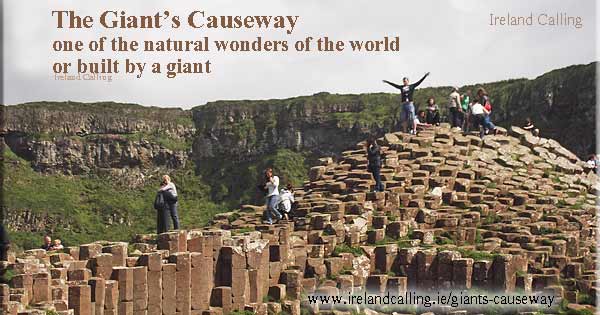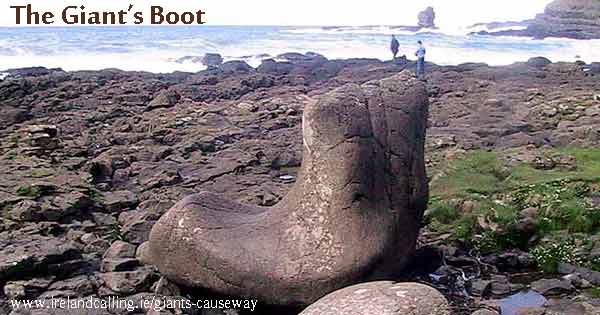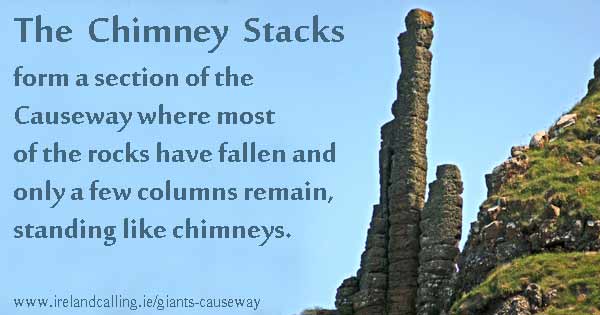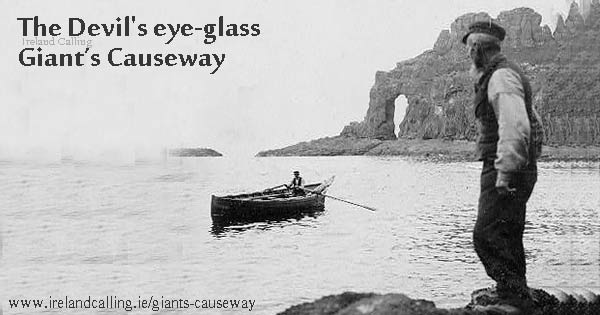The Giant’s Causeway is considered by many to be the eighth wonder of the world and it has become a major attraction for holidaymakers.
Giant’s Causeway formation
Attractions in Ireland
It fascinates both tourists and scientists alike, and has been declared a World Heritage Site.
Scientists have shown that the Giant’s Causeway was formed by a volcanic eruption, but Irish mythology says it was built by the giant Finn MacCool.

Columns of rock rise mysteriously from the sea
The Causeway is made up of 40,000 large hexagonal shaped columns of rock that emerge mysteriously from the sea to form a massive pathway on to the Antrim coast.
You can reach them by walking about half a mile along a public footpath. Hundreds of thousands of people visit the Causeway every year. It is particularly busy in the summer.
Discovered by modern man in 1692
The Causeway was discovered in 1692 by the Bishop of Derry. He told scholars in London and Dublin about his discovery and soon the debates started raging about how the Causeway was formed.
Many thought it had been built by humans, others thought it was a natural occurrence while some believed it had been placed there by God.
By the 1700s it was hailed by many as the eighth natural wonder of the world and began attracting a growing number of tourists every year.
The Causeway used to be fenced off by the rich
It’s free to visit the Giant’s Causeway but there is a charge to go to the visitor centre – open from summer 2012. The visitor’s centre includes information about the causeway and you can book a guided tour.
It wasn’t always free to visit. In the 1800s, the Causeway was fenced off by landowners who saw its potential as a tourist attraction and so an easy way to make money. They started to charge tourists to see the Causeway.
After a long drawn out court case it was judged that the road to the Causeway should be freely available to the public but the stones themselves could be fenced off and the landowners could charge for access to them.

However, local protests continued with people insisting the Causeway should be seen as public property and freely available to everyone. Eventually, the protestors won the legal argument. The courts ruled that the public had an ‘ancient right of way’ to visit the Causeway and view the stones.
Features of the Giant’s Causeway
The rock formations in the Causeway have produced shapes which have been given names and become tourist attractions in themselves. Among the most popular with holidaymakers are:

The Giant’s Gate is a gap at the end of the causeway. At this point the columns are huge and you walk through them to get to Port Noffer.
The Giant’s Boot is a boot shaped piece of rock on the coastal path at the Giant’s Causeway.
The Giant’s Organ is at Port Noffer. From here you are at ground level with the Causeway rather than walking on top of it and some of the columns resemble organ pipes.
The Wishing Chair was the childhood chair of the legendary Irish giant Finn MacCool. It’s said that if you make a wish while you are sitting in it, your wish will come true.
The Chimney Stacks are a section of the Causeway in which most of the rocks have fallen and only a few columns remain, standing like chimneys.

The Giant’s Harp is on the east side of the Causeway and consists of a number of columns that are now in the cliff face that were curved into the shape of a harp, probably in the cooling process.
The Giant’s Eyes can be seen in the circular shapes formed by weathering of some of the rocks.

There are several of these features at the Giant’s Causeway. They add to the legend of the area and make it more entertaining for young families.
Giant’s Causeway
Giant’s Causeway formation
holidays.html
